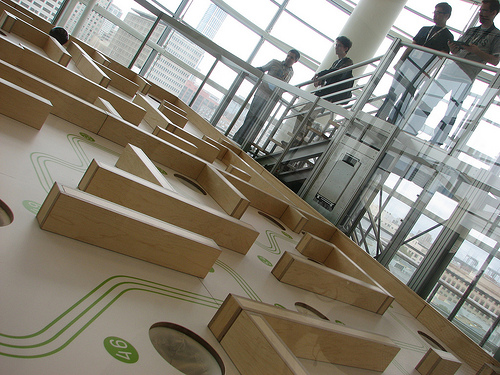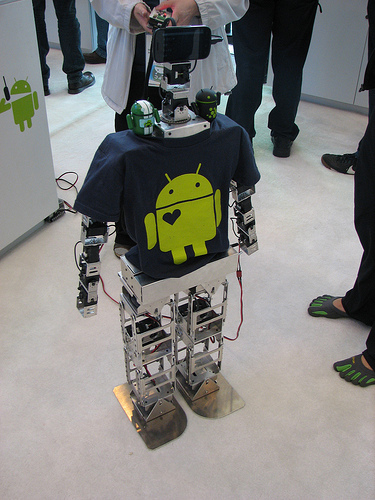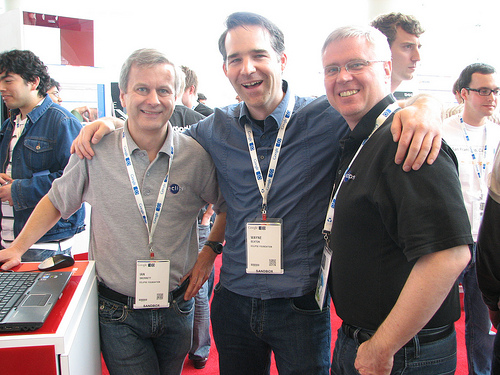The just-concluded Google I/O featured many juicy morsels on display. Here are five of the sweetest things from the company’s smorgasbord:
The Arduino open-source electronic prototyping platform is popular with the sorts of folks you read about in Wired, Make Magazine and Boing Boing: the cutting-edge home-brew technology developers. It’s so popular that there are even a few clothing-embeddable implementations. And Google’s basing its newly announced Accessory Development Kit on the Arduino platform.
At the conference, the hottest toy in the crowd was the ADK, which was handed out to the developers who were lucky enough to get into the right sessions. Others at the conference were given Android phones in exchange for attending talks by Sony Ericsson, but I watched as one developer called out to trade his Sony PSP/Android phone for an ADK. They were like pure gold.

With the ADK, Google built a massive version of the wood-and-marble game Labyrinth. It’s a popular game on the Android Marketplace, with phone tilts emulating the knobs built into the game board. That was no different for the larger-than-life implementation of this game on display at Google I/O; players stood on a platform above the game and tilted a tablet to control the thing. It was a terrific way to demonstrate the unending stuff people can do with Arduino and Android.
#!

There were rather a lot of robots at Google I/O. From iRobot’s telepresence and retail-focused armature-on-wheels variety, to the little green Androids that balanced Segway-like upon two wheels, robots were all over the conference. While none of those on display are likely to be in your local hardware store anytime soon, they were remarkable to observe and learn about.
The rather futuristic-looking PR2, shown above, is evidently the product of an endless budget, coupled with no concrete demand for marketability. Despite all of this, you may notice that it uses a Microsoft Kinect atop its expensive carapace. The Kinect, you see, has set the robotics world on fire. It’s truly the best spatial recognition and object-detection hardware in existence. And it’s only US$150. Oh, how robotics has changed.

The iRobot telepresence ladies were my personal favorite. These little three-wheeled robots consisted of basic mobility and object-avoidance hardware, festooned with a simple extending post that could rise or fall upon need. Atop that post was an Android tablet, of course. These girls (their gender indicated by their names) would whiz through the crowd, then extend the tablet up toward a passerby. The “customer” could choose to have his or her picture taken in 3D, which could be retrieved at the booth. These were by far the most engaging and autonomous robots in the conference.
#!
Velocity has always been the big focus of Go, both in terms of developer productivity and in terms of application performance. To that end, the entire tool chain is designed with continuous integration built in. This capability has now been extended into AppEngine.

What that means is that developers who are building with Go can now upload their raw code to AppEngine, and it will be compiled and run in the cloud, hands-free. The environments for development and deployment are the same, and there are no compiler flags to throw or fiddle with. It’s Google’s language running in Google’s cloud. There really isn’t any other company that can offer their own high-level language in their own cloud.
#!

The end-goal of Orion is to offer a versatile platform for the creation of browser-based IDEs. This is a tad different from the previous attempts to build Web IDEs, and it’s uniquely Eclipse: build the platform, not the language specifics. Orion could very easily be the future work environment for all of your developers five years from now. But for now, it’s just an intriguing toy, right?
Well, it would be if Google hadn’t introduced…
#!
That’s because the Chromebook is that network computer we all haven’t been hearing about for eight years now. Remember the years before that, around the turn of the century? Little did Oracle and others know that the real secret to transparent compute hardware was an impeccable retinue of cloudy services.

There is a very distinct difference between those who love the Chromebook and those who hate it; those who hate the idea of Chromium and the Chromebook have clearly never worked full time in tech support. I have, and let me tell you, the Chromebook and the model it represents are going to put tech support out of business.
Or maybe not. After all, Chromebook very succinctly ensures that the only possible solution to your problem will always be, “Have you tried turning it off and back on again?”






